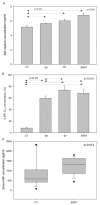Involvement of HPV Infection in the Release of Macrophage Migration Inhibitory Factor in Head and Neck Squamous Cell Carcinoma
- PMID: 30634708
- PMCID: PMC6352225
- DOI: 10.3390/jcm8010075
Involvement of HPV Infection in the Release of Macrophage Migration Inhibitory Factor in Head and Neck Squamous Cell Carcinoma
Abstract
Human papilloma virus (HPV) infection has been well-established as a risk factor in head and neck squamous cell carcinoma (HNSCC). The carcinogenic effect of HPV is mainly due to the E6 and E7 oncoproteins, which inhibit the functions of p53 and pRB, respectively. These oncoproteins could also play a role in the Warburg effect, thus favoring tumor immune escape. Here, we demonstrated that the pro-inflammatory cytokine macrophage migration inhibitory factor (MIF) is expressed at higher levels in HPV-negative patients than in HPV-positive patients. However, the secretion of MIF is higher in HPV-positive human HNSCC cell lines, than in HPV-negative cell lines. In-HPV positive cells, the half inhibitory concentration (IC50) of MIF inhibitor (4-iodo-6-phenylpyrimidine (4-IPP)) is higher than that in HPV-negative cells. This result was confirmed in vitro and in vivo by the use of murine SCCVII cell lines expressing either E6 or E7, or both E6 and E7. Finally, to examine the mechanism of MIF secretion, we conducted proton nuclear magnetic resonance (¹H-NMR) experiments, and observed that lactate production is increased in both the intracellular and conditioned media of HPV-positive cells. In conclusion, our data suggest that the stimulation of enzymes participating in the Warburg effect by E6 and E7 oncoproteins increases lactate production and hypoxia inducible factor 1α (HIF-1α) expression, and finally induces MIF secretion.
Keywords: 4-IPP; HNSCC; HPV; MIF; metabolism.
Conflict of interest statement
The authors declare no conflict of interests.
Figures






Similar articles
-
Liberation of functional p53 by proteasome inhibition in human papilloma virus-positive head and neck squamous cell carcinoma cells promotes apoptosis and cell cycle arrest.Cell Cycle. 2013 Mar 15;12(6):923-34. doi: 10.4161/cc.23882. Epub 2013 Feb 19. Cell Cycle. 2013. PMID: 23421999 Free PMC article.
-
Expression of human papillomavirus oncoproteins E6 and E7 inhibits invadopodia activity but promotes cell migration in HPV-positive head and neck squamous cell carcinoma cells.Cancer Rep (Hoboken). 2018 Oct;1(3):e1125. doi: 10.1002/cnr2.1125. Epub 2018 Jul 27. Cancer Rep (Hoboken). 2018. PMID: 32721084 Free PMC article.
-
EGFR-induced suppression of HPV E6/E7 is mediated by microRNA-9-5p silencing of BRD4 protein in HPV-positive head and neck squamous cell carcinoma.Cell Death Dis. 2022 Nov 4;13(11):921. doi: 10.1038/s41419-022-05269-8. Cell Death Dis. 2022. PMID: 36333293 Free PMC article.
-
Cellular targets of the oncoproteins encoded by the cancer associated human papillomaviruses.Princess Takamatsu Symp. 1991;22:239-48. Princess Takamatsu Symp. 1991. PMID: 1668886 Review.
-
Metabolic Reprogramming in Cancer: Role of HPV 16 Variants.Pathogens. 2021 Mar 16;10(3):347. doi: 10.3390/pathogens10030347. Pathogens. 2021. PMID: 33809480 Free PMC article. Review.
Cited by
-
DNMT1 Enhances the Radiosensitivity of HPV-Positive Head and Neck Squamous Cell Carcinomas via Downregulating SMG1.Onco Targets Ther. 2020 May 15;13:4201-4211. doi: 10.2147/OTT.S227395. eCollection 2020. Onco Targets Ther. 2020. PMID: 32523356 Free PMC article.
-
Assessment of macrophage migration inhibitory factor in patients with verruca vulgaris.Clin Cosmet Investig Dermatol. 2019 Aug 22;12:591-595. doi: 10.2147/CCID.S209269. eCollection 2019. Clin Cosmet Investig Dermatol. 2019. PMID: 31686887 Free PMC article.
-
Unraveling Immunological Dynamics: HPV Infection in Women-Insights from Pregnancy.Viruses. 2023 Sep 27;15(10):2011. doi: 10.3390/v15102011. Viruses. 2023. PMID: 37896788 Free PMC article. Review.
-
Pleiotropic role of macrophage migration inhibitory factor in cancer.Am J Cancer Res. 2019 Dec 1;9(12):2760-2773. eCollection 2019. Am J Cancer Res. 2019. PMID: 31911860 Free PMC article.
-
STAT5 Is Necessary for the Metabolic Switch Induced by IL-2 in Cervical Cancer Cell Line SiHa.Int J Mol Sci. 2024 Jun 21;25(13):6835. doi: 10.3390/ijms25136835. Int J Mol Sci. 2024. PMID: 38999946 Free PMC article.
References
-
- Global Burden of Disease Cancer Collaboration. Fitzmaurice C., Allen C., Barber R.M., Barregard L., Bhutta Z.A., Brenner H., Dicker D.J., Chimed-Orchir O., Dandona R., et al. Global, Regional, and National Cancer Incidence, Mortality, Years of Life Lost, Years Lived With Disability, and Disability-Adjusted Life-years for 32 Cancer Groups, 1990 to 2015: A Systematic Analysis for the Global Burden of Disease Study. JAMA Oncol. 2017;3:524–548. - PMC - PubMed
-
- Saraiya M., Unger E.R., Thompson T.D., Lynch C.F., Hernandez B.Y., Lyu C.W., Steinau M., Watson M., Wilkinson E.J., Hopenhayn C., et al. US assessment of HPV types in cancers: Implications for current and 9-valent HPV vaccines. J. Natl. Cancer Inst. 2015;107:djv086. doi: 10.1093/jnci/djv086. - DOI - PMC - PubMed
-
- Chera B.S., Kumar S., Shen C., Amdur R.J., Dagan R., Weiss J., Grilley-Olson J., Zanation A., Hackman T., Blumberg J., et al. Plasma Circulating Tumor HPV DNA for the Surveillance of Cancer Recurrence in HPV-associated Oropharyngeal Cancer. Int. J. Radiat. Oncol. 2018;102:1605–1606. doi: 10.1016/j.ijrobp.2018.08.053. - DOI - PMC - PubMed
-
- Gupta G.P., Kumar S., Marron D., Amdur R.J., Hayes D.N., Weiss J., Grilley-Olson J., Zanation A., Hackman T., Zevallos J.P., et al. Circulating Tumor HPV16 DNA as a Biomarker of Tumor Genomics and Disease Control in HPV-associated Oropharyngeal Squamous Cell Carcinoma. Int. J. Radiat. Oncol. 2018;100:1310–1311. doi: 10.1016/j.ijrobp.2017.12.291. - DOI
Grants and funding
LinkOut - more resources
Full Text Sources
Research Materials
Miscellaneous

